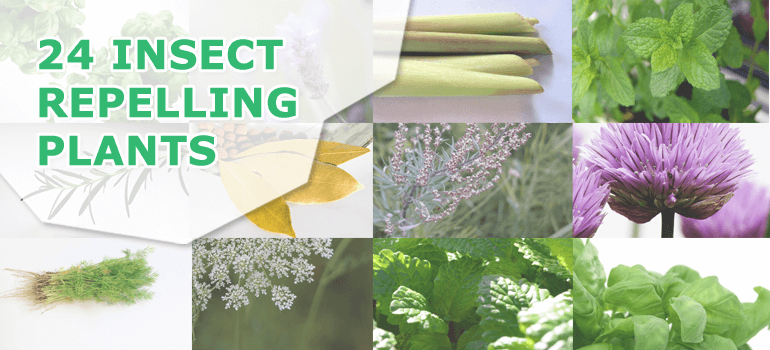
Plants have unique natural abilities to emit different chemical substances. With them they repel or attract specific insects. Flowers bring a pretty sight and a pleasant fragrance for us. However, for pests they often pose a life threat. That’s why such plants can perfectly serve as a replacement for the synthetic insecticides, as long as you know how to use this to your advantage.
Quick rundown
Here’s the take out of the unwanted insects and their respective bane:
- Plants that repel mosquitoes – lavender, mint, basil, rosemary, lemon balm, lemon grass, nepeta, mugwort, marigolds, ageratum, oregano, bee balm, cedar tree;
- Plants that repel flies – lavender, basil, rosemary, bay leaves, mugwort;
- Plants that repel moths – lavender, mugwort;
- Plants that vegetable bugs – rosemary, chives, fenel, parsley, marigolds, lemon thyme, dill, chryzanthemums, nasturtiums, petunias, alliums;
For a thorough look on specific plants and the reasons behind their seemingly magical effects, dig in below.
Herbs that repel insects
Lavender

Apart from mosquitoes, lavender oil can chase other bugs, such as fleas, flies and moths. Many peoples have used it for thousands of years to scent their homes and clothes. A bouquet of lavenders will keep bugs away, but the most effective is lavender essential oil.
You can make it yourself, or purchase it from the nearest natural drug store. The liquid will not only act as a natural repellent, but it can also calm your heart rate and bring you a better sleep. There’s one thing you should be wary of when it comes to essential oils – never leave them to come in contact with your skin.
The essential oils always come with a “carrier” – another substance in which only a handful of drops go in. This extract is too strong even for a resilient skin.
Mint

Since ancient times, mint was used to strengthen the mind. Greek and Roman baths, as well as feast rooms, were infused with mint that helped boosting concentration. Until the 17th century, mint was used to spice to the meals of both poor and rich folk. Later on during the 18th century it disappeared from sight, until present days.
Although a domesticated plant, the mint still spreads like weeds if left in the ground, therefore it’s best to grow it in pots. You can use mint essential oil in a combo with a cheap vodka and apple cider vinegar to create a homemade repellent for mosquitoes. Placing mint pots around your patio and garden will also help you keep mosquitoes away.
Basil

Basil is rich in essential oils, tannins, organic acids and mineral salts. The birthplace of the so-called king’s herb, are the tropical geographic lengths of Asia and Africa. Yet, the basil has been highly praised in Europe for centuries.
It’s connected with ancient mythologies, and was used in balsaming the diseased in Egypt. At the time of the Roman Empire, the suitors used a basil stalk instead of a flower bouquet as a symbol of love. In Mexico, on the other hand, people believed that a spray of basil in the pocket will bring you money, whereas your loved one will be faithful forever.
In Europe, during the Middle Ages, the folk assumed that scorpions lurk under it. Its name comes from the Greek word for royal – basilico, whereas according to the Indian religion its flavour is sacred.
Mosquitoes are repulsed by the basil scent. A pot of basil, or a stalk hung is a natural repellent. Some people say that if you eat lots of basil with your salad, it will repel the annoying mosquitoes far away, but that’s yet to be confirmed. In any case, basil’s one of your best chances of survival against those pesky little creatures, plus it adds a unique flavor to your dish, so why not abuse on it!
Rosemary
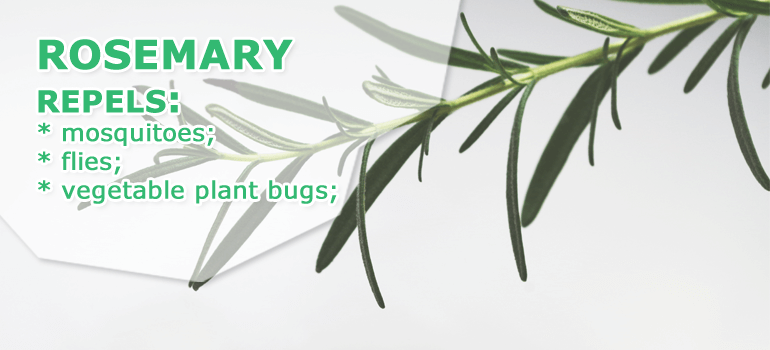
The rosemary’s origins are Mediterranean, whereas its forestry citrus-like aroma adorns kitchens, gardens and pharmacies all around the world. Connected with names, such as sea dew and old man, the rosemary looks like lavender, with flat needle-like leaves.
The rosemary is one of the herbs that are multifunctional. It’s extremely resistant to outer conditions, therefore, it’s easy to grow both in and out of the house. However, it needs a lot of sunlight if the pot is inside your home, but it doesn’t require too much warmth and air humidity. Sprinkling the plant with water several times a week will suffice.
Rosemary repels not only the bad old mosquitoes, but also different vegetables, that’s why it is a recommended companion plant. To prepare a rosemary repellent you need to boil about 1 kg of dried rosemary in 1 litre of water for about half an hour and then strain the liquid into a litre of cool water. Spraying with small bottles outdoors will help you repel a good portion of the mosquitoes away.
Lemon Balm
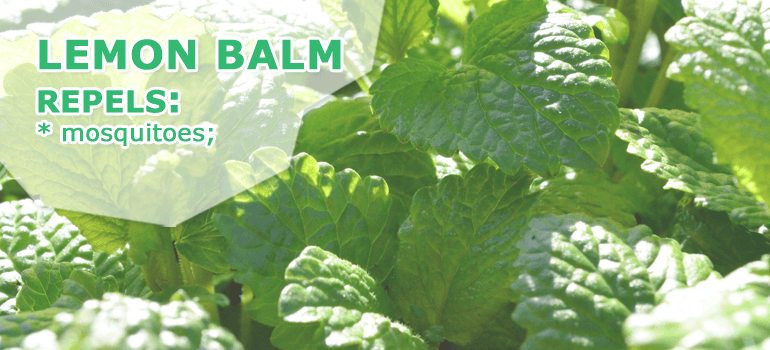
The lemon balm (Melissa officinalis) is a well-known ingredient in herbal teas.
The lemon balm originates from the mountain regions of Southern Europe. Since ancient times, it’s been used by the Persians and Greeks for treating different diseases, caused by neuro system problems. Having lemon balm in your garden will repel mosquitoes too, thanks to the natural essential oils and strong smell of the plant.
Lemongrass
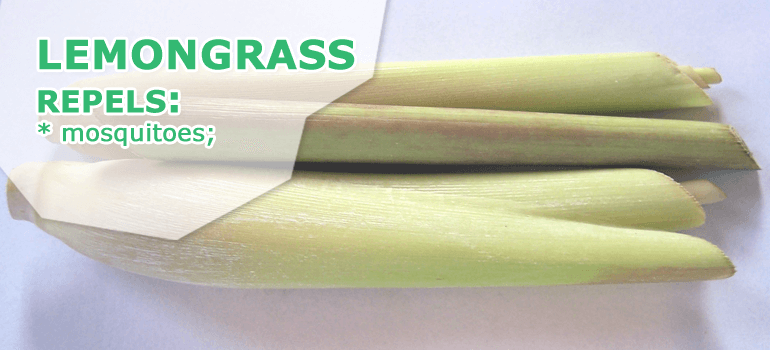
The lemongrass, also called cymbopogon, is a perennial tropical grass plant. It has tall sharp leaves and reaches around 15 cm. The birthplace of the plant is India, but people also grow it in Sri Lanka, Indonesia, Africa, Brazil, and Guatemala.
The lemongrass oil has antiseptic and anti-mucus properties and helps with insomnia, too. The lemongrass oil also acts as a repellent – not only mosquitoes but flies and other unwanted bugs stay away from it.
Just as the basil, the lemongrass is used as a herb and a spice for culinary purposes, both fresh or ground.
Bay Leaves
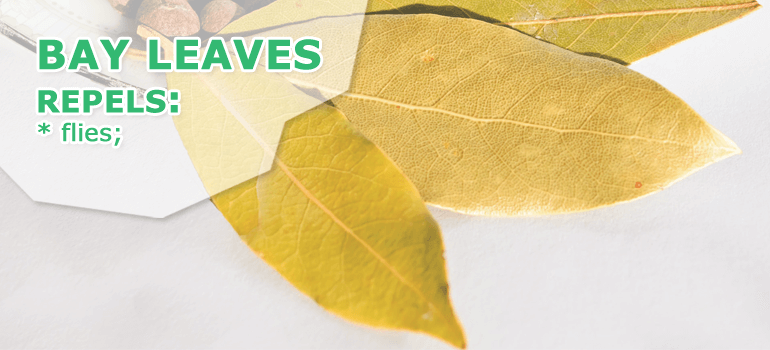
Bayleaf is just another sacred for ancient Greeks and Romans plant. It carries a ton of healing properties, which are as strong as its smell. It helps with stomach, kidney and liver problems, too. It makes the rankings here, because it’s a great fly repellent.
The annoying little creatures will disappear at the sight of it. Several strategically placed bowls of bay leaves in your rooms will take care of this business. And by the way, did we mention bay leaves are a wonderful condiment to different soups and stews? Bring it on!
Lemon thyme
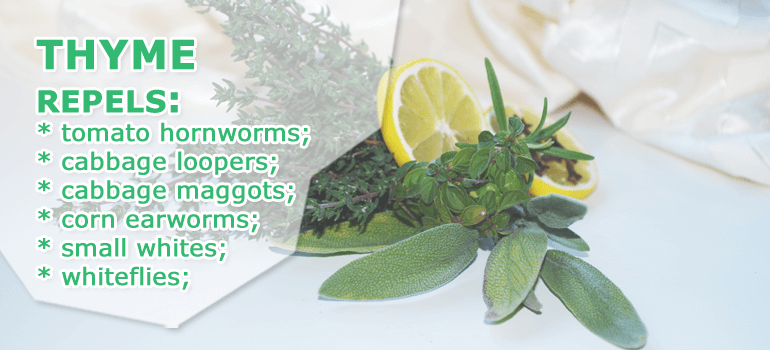
The lemon thyme is a bush, reaching 50 cm in diameter. It’s evergreen, with yellow-green small leaves that smell like lemon. The fully-grown plants blossom during the summer with pink, lavender-like flowers.
The herb was first used somewhat 5000 years ago when the Sumer civilisation began to use it as a means of soothing pain. The ancient Greeks began using it as a culinary supplement – the hills of the country were practically covered with the fragrant plant, which gradually turned into a symbol of elegance and courage.
The Romans also associated it with bravery and power and before entering a battle, the soldiers bathed in water, aromatized with the herb, because they believed it will bring them the win on the field.
In order to infuse its qualities and repel the nasty mosquitoes, you must first release the chemicals in the plant by crushing the leaves. Make sure that, at first, you are not allergic to those chemicals by smearing a piece of crushed leaf on your arm for a few days.
Dill

It’s a well-known herb all over the world and it’s widely used in culinary. A proof of its healing properties can be the fact that the gladiators in Ancient Roman Empire used to eat dill in order to be strong and tenacious.
However, one of the oldest mentions of the herb’s name is in the Bible. You guessed it right – dill is an invaluable helper in the battle with different vegetable pests – tomato hornworms, aphids, spider mites, cabbage loopers, and squash bugs, to name a few. The fennel kind, on the other hand, keeps slugs and snails at distance.
Oregano
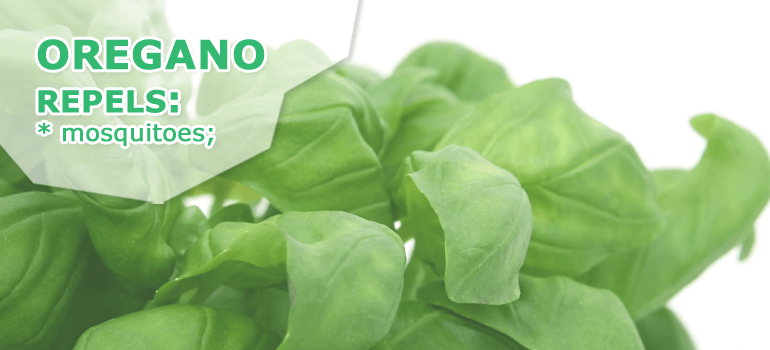
Oregano is one of those universal spices used throughout the world and is well-known to everyone who’s spent at least some time in the kitchen. Not many knows, on the other hand, that oregano belongs to the family of natural insect repellents. Mosquitos, cabbage butterfly, and cucumber beetle don’t stand a chance, amongst others, however, some insects won’t bother, such as spider mites, leafhoppers and aphids. Therefore, you can plant the oregano near garlic and onions.
Apart from those bugs, you can dry and grind the plant’s overground part and use it against moths and ants infestations in your house. If it doesn’t prove to be as useful against ants as you’d hoped, then consider some of our more serious ant killer tactics. These methods work both for ants in your home and garden.
Mugwort

Common mugwort (Artemisia absinthium L.), also known as white mugwort or yomogi in Japan, is a grass perennial and fragrant plant. It grows on meadows and bushes, in grassy and rocky areas. Its origins stem from Europe and Siberia, but today it’s widely spread in the USA as well.
The white mugwort has a typical pleasant flavour and a strong bitter taste. Its beautiful, silver-green leaves may be the most famous for absinthe distillation usage, but that’s not all. Its natural essential oils emit a distinctive smell which does a great job at repelling not only flies, but also insects such as mosquitoes and moths, and even small pests, like mice.
Plant them in pots around the garden, or grow them directly in the soil. You can also dry some of the herbs and place it in small bags where necessary.
Chives
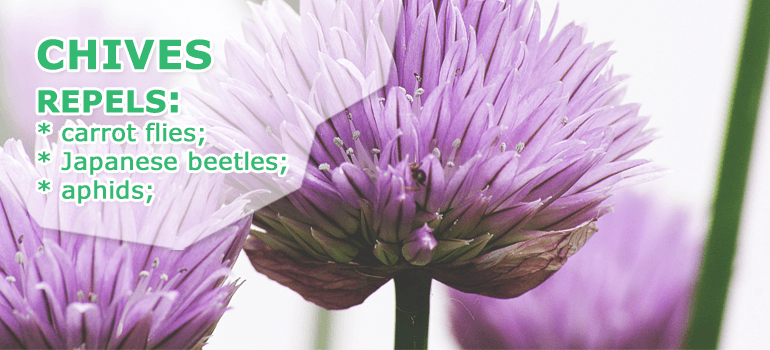
Chives (Allium schoenoprasum) with its fine green feathers is the smallest kind of edible onion. The chives is a perennial plant, reaching 50 cm at height, and it originates both from the New and the Old World.
The chives is a popular plant, used predominantly as a culinary spice, but not many people know it also repels carrot flies, aphids and Japanese beetles.
Fennel

The history of fennel is as rich as its taste. In Ancient Greece, it played an important role in honouring the gods. It was planted in their honour in the shrine gardens, whereas people wore wreaths made of its light leaves. The plant was famous in ancient Egypt, China, India, Rome, and Persia. They considered it improves eyesight.
They also believed that this plant helps for curing digestive and neuro system problems. It was used as food, medicine, herb and plant repellent for centuries. Aphids, slugs, and snails don’t stand a chance near the fennel strong smell, which is due to the essential oils found in the fennel.
Parsley

Although, generally, you wouldn’t put parsley in the category of natural mosquito repellents, parsley does contain chemicals that repel asparagus beetles. So it makes sense to plant it around asparagus and other susceptible to those bugs cultures.
Flowers that repel insects
Marigolds
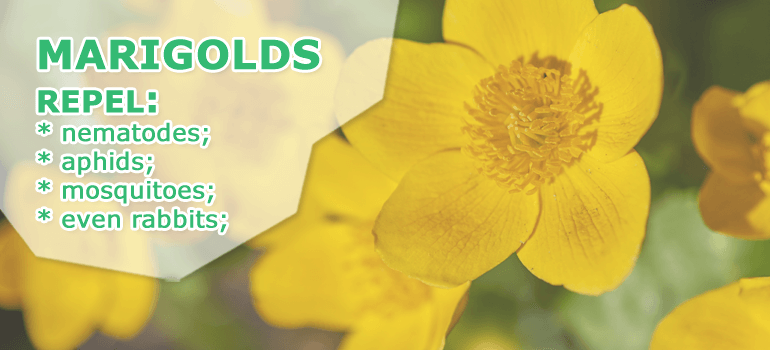
In the wild marigolds are agile and also happen to grow out of dumping-grounds. The marigold is a peculiar barometer – if the blossoms remain closed after 7 in the morning, then it means it will rain during the day.
There are different kinds of marigolds – lighter and darker, with larger and smaller blossoms, but they all carry the same health benefits. Plus, marigolds’ smell chases off not only aphids and mosquitoes but also big animals such as rabbits.
The flower contains essential oils, bitter compounds, carotene, organic acids, flavonoids, etc. It’s no accident that the marigold potion is pretty bitter. Its fragrance dissolves well in alcohol, which explains its wide usage in different skin creams.
Ageratum
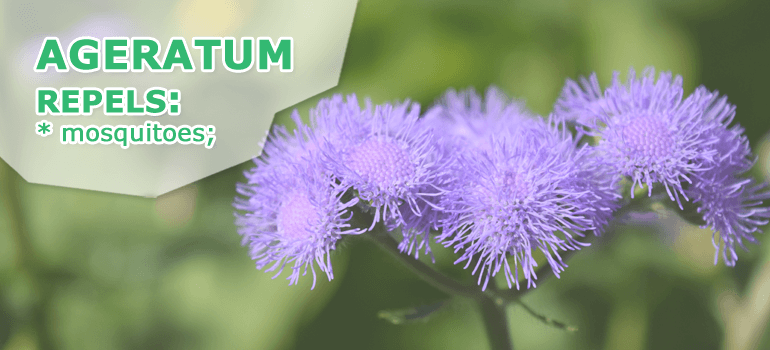
This seasonal flower effectively repels mosquitoes with its fragrance. During production of some repellents, one of the important ingredients comes from the plant. However, it’s not recommended to rub your skin with ageratum leaves . That might cause unwanted and very unpleasant allergic reactions. The ageratum is extremely easy to grow – undemanding to the soil and light-loving.
Chrysanthemums
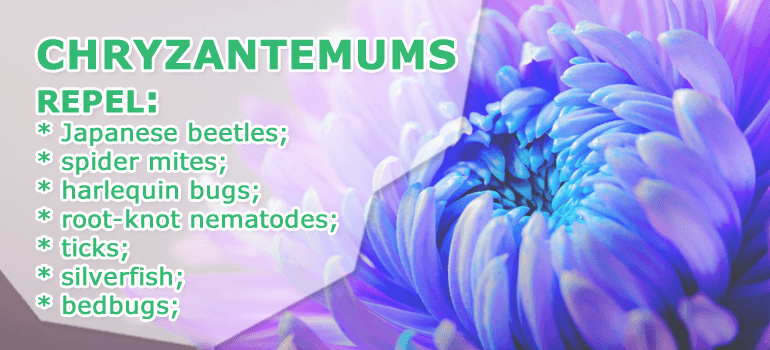
A special chemical in the chrysanthemums, called pyrethrum, is the thing that keeps bugs away. Roaches, ticks, fleas, bed bugs, spider mites, Japanese beetles and ants – be gone. The ingredient is part of different insecticides in the USA and is used in sprays and flea pet shampoos. Be careful with the spray bottles, if you happen to have one, since pyrethrum is poisonous to people in certain amounts.
Nasturtiums

Nasturtium is not only beautiful but also a useful plant. If you plant it next to tomatoes in your vegetable garden, it will chase off the dangerous whiteflies. Also, aphids, beetles and squash bugs stay away from the plant. The cabbage looper, on the other hand, will prefer to lay its eggs on the nasturtium, therefore, your cabbage will be safe. The flower is also a part of traditional medicine due to its chemical compounds.
Petunias
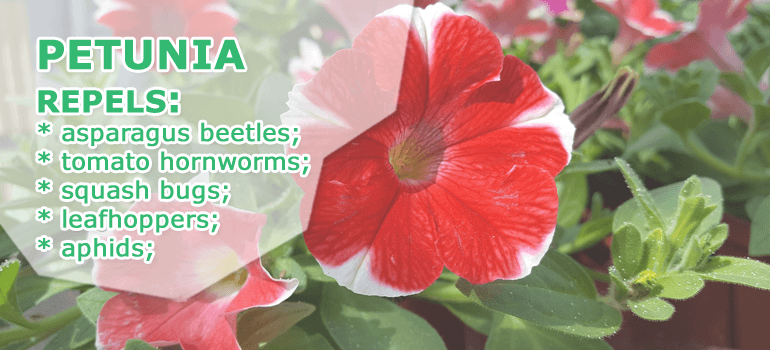
Petunia is one of the most popular domestic plants during the last decades. This colourful and tufty appearance is a result of numerous breed attempts. You may have never suspected, though, that petunias also can help dealing with nasty insects. They don’t directly kill or repel them, but more likely they trap them with their sticky stamens.
The insects can’t get away and eventually die and dissolve in the soil, where they become nutrients for the plants. Pretty gruesome for such a beautiful plant! Since it deals with aphids, asparagus beetles and tomato hornworms, you can plant it near crops that can benefit from the plant’s natural abilities.
Nepeta
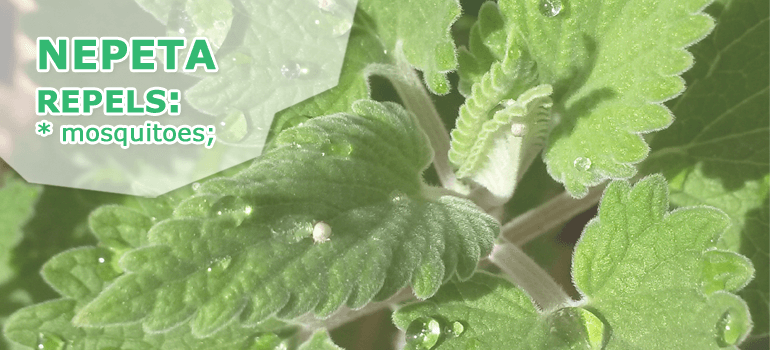
This plant is also known as catmints, which is a milder version of the famous catnip. As you guessed it, the nepeta plant also attracts cats like flies on honey. On the other hand, it does a successful job at repelling mosquitoes.
The effect is due to nepetalactone, which, according to researches made, can be up to 10 times stronger than DEET – an active ingredient in most commercial repellents. It’s still not established whether this ingredient or the smell of catmint repels mosquitoes. Some of the other advantages of this perennial flower are the easiness to grow and the fact that it attracts bees.
Alliums

Alliums are a flowering form of onions and garlics. Allium giganteum repels a wide range of insects, especially the ones that destroy vegetable gardens, such as slugs, cabbage worms, carrot flies and aphids. You can plant alliums closely to potatoes, cabbage, tomatoes, carrots and peppers. Some flower bushes can also benefit from the nearby alliums, such as roses.
Bee Balm
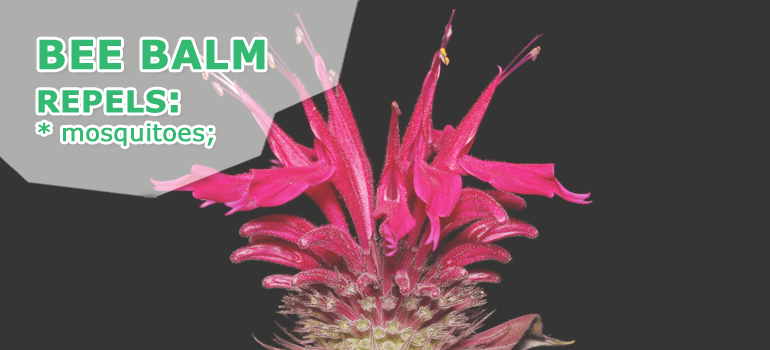
Bee balm (Monarda fistulosa) is known as a beautiful flowering perennial essential oil plant, as well as a vegetable plant with a spicy taste. It possesses valuable health benefits, too. Thanks to the essential oils, found in the plant, it repels mosquitoes. They can do that while still blooming, but it’s easier for the plant to release its natural abilities to chase off the annoying bugs by grinding its leaves.
Bonus
Carnivorous plants

Of course, it’s a witty way to represent the carnivorous plants family, which, in fact, are quite picky about food and conditions of the environment, so have double eyes when you buy one for yourself.
The pleasant colours and smells attract the unsuspecting bugs to their slow demise. Some of those fly-catchers and venus traps could make a nice addition to your garden. Be wary though – they require a bit of care in order to grow well, particularly considering the watering amounts.
Cedar tree
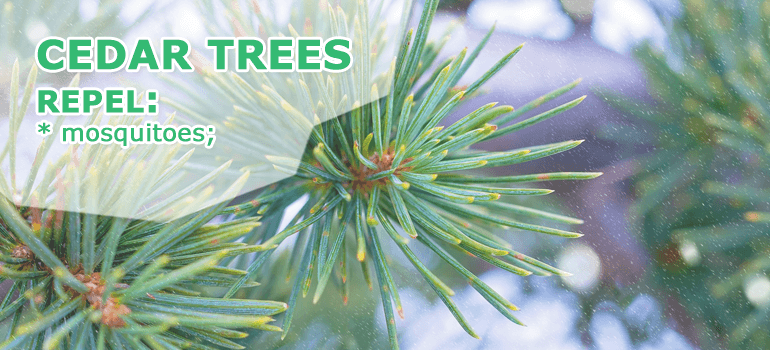
The advantages of having a cedar tree in your garden do not exhaust with its pretty outlook. It will also repel unwanted mosquitoes. The cedar oil’s bug-repellent qualities were familiar since Ancient Egypt. At the time, the folk used it to embalm their dead, only because it chases off bugs.
People don’t always extract cedar oil from the cedar three, though. Sometimes this essential oil can come from conifer trees or cypress. Apart from pest repellent ingredient, it is used in medicine and in perfumes.
Although all these plants have natural abilities to repel mosquitoes and other unwanted pests, you will find that they are not always effective. Especially when it comes to outside factors, such as a light breeze that will swing off the smell in an opposite direction. Nevertheless, you can incorporate different combinations of the given herbs and plants, and be one step ahead in the never-ending battle with pesky insects.
Need a professional gardener?
Enter your postcode to view our rates and availability in your area.
For questions about the services we offer visit our main site or you can always call us at 020 3404 4881
***
Did you like it? Did you find the plan you were looking for? Do you have any additional tips regarding insect-repelling plants? Please, add a comment below if you know any other plant that repels insects so that more people are aware and help the community of fellow gardeners!




You gave me a lot of good information.
I would like to know if the fly & mosquito repellent plants grow well in sunny areas.
Hello Karen!
We are glad to know that you liked the post! To answer you question – it actually depends on the plant. To be more precise:
The plants that prefer full sun are lavender, basil, lemongrass, nepeta, marigolds, oregano and bay leaves.
The plants that can tolerate shadow, but still thrive more under sun, are rosemary, lemon balm, mugwort, ageratum and bee balm.
The only plant that is better off in a shadier place is mint.
Hope this helps you!
If these some of the plants,flowers etc repels insects flies what about about bees?as this is one insect I don’t won’t to harm
Hey Lindy,
Bees generally don’t have any plants that they are afraid of or repelled by. They only find plants without flowers unattractive, since there is hardly a way for them to get pollen out of them. However, you won’t have trouble attracting bees to your garden if you plant flowers and flowering plants. If you are interested in developing a wildlife garden, you can check our article on the matter here.
Regards!
Hi we have ALOT of gnats on a plot of land we’ve recently purchased, and my husband has been bitten terrible whilst working on the land. Theres quite a few wimberry bushes and trees, aswell as brambles, which we are currently trying to clear…..could we plant any of the above in pots to stop the gnats?? Any advice would be very much appreciated, thank you in advance.
Hello Lisa,
When we talk about a bigger yard, garden or open air space, it might be a bit more difficult to battle gnats with plants in pots. You may try, of course, but it will depend on the size of the land. We recommend using natural pesticides, such as nematodes. They are quite effective and you can purchase them online. Follow the package instructions – you should use lukewarm water, not too hot as they are living creatures, when you sprinkle the soil with them. The soil must be irrigated, too. Don’t use chemical pesticides together with nematodes though as this will kill them off.
Another way you can battle gnats in the open air is by making your garden totally unwelcoming for them. Avoid moisture build-up, meaning let your land space dry out more before watering again (if that’s possible of course). Inspect your land for any decaying organic matter and get rid of it, as well as leaves, dead plants, grass clippings, etc. Don’t use peat moss beds – gnats love it. You can also try to decrease their population by attaching fly sticky strips of paper where gnats thrive.
Hopefully these natural methods will help you and you won’t have to resort to chemical methods.
Regards,
Fantastic Gardeners Team
Can I plant fennel and sweet basil in the same pot/trough?
Hello Andee,
Fennel might not work well with basil, because of fennel’s height – it will look out of place next to shorter basil. In general, fennel might not work well as a companion plant in a container due to its deep root system. But it works well if placed alone in a big container.
Hi Can you tell me how far ranging the effects of the above plants are, especially those for mosquitoes? My daughter is having an outdoor wedding later this month at a venue that doesn’t spray for bugs. If we make pots of bug repelling plants, I’m just wondering if a few down the aisles will do it for everyone or not. I appreciate your help.
Hey Joanie, You can try with mosquito repelling candles (mason jars with essential oils), check out the following article.
I began to wonder while reading this if a potpourri of dried leaves and flowers would help in a small apartment in southern Michigan. Also please note that i don’t wish to repel women from these options either.
Actually you can try it out, Tim. We’ve heard of cases when potpourri help chase off bugs. You can be safe about the second part, too – potpourri do brighten up a place!
Hi there, we have a lot of problems with midges/no seeums ( those nasty swarming flies because we live close to water) Any thoughts on how to deter those swarming little bugs?
Love, love, love lavender. It’s scent can help me relax in a heartbeat. Thrilled to see it on the top spot. Excited to try these other plants, too.
Lavender owns one of my favorite scents in the world, that’s why I planted some of them in our home. It’s great to know it also helps repel insects! Win win! Thanks for these other plant suggestions. Considering on adding bee balm and petunia soon!
I love my scented herbs! Especially the lavender which can be tricky to grow in the Mid Atlantic. I like to raise it in pots so I can move it to the desk or onto the patio (based on the sun’s movement through the seasons). I think it may help with mosquitoes but either way, I enjoy having it nearby.